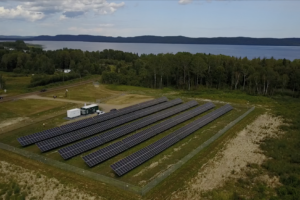


Episode 04
Ron Dizy: Venture capital bets on net-zero
 The race to net-zero is on, but we won’t reach our targets without major, transformative changes to the ways we generate, store and use energy. Ron Dizy is a venture capitalist specializing in energy technologies and the former leader of the Advanced Energy Centre at MaRs. As the world transitions away from fossil fuels, Ron sees real opportunities to benefit from investing in the clean energy infrastructure of the future and is putting his money where his mouth is by betting on the ideas he thinks will win out.
The race to net-zero is on, but we won’t reach our targets without major, transformative changes to the ways we generate, store and use energy. Ron Dizy is a venture capitalist specializing in energy technologies and the former leader of the Advanced Energy Centre at MaRs. As the world transitions away from fossil fuels, Ron sees real opportunities to benefit from investing in the clean energy infrastructure of the future and is putting his money where his mouth is by betting on the ideas he thinks will win out.
On episode 4 of The Climate Challengers, Ron and Andrea get into new and emerging technologies with the potential to steer us safely to 2050—and beyond. From carbon capture and storage to grid scale batteries to small modular reactors and hydrogen — if you are at all curious about how the transition to net-zero could play out, don’t miss this episode.
Betting on green: New and emerging technologies
Every day, human activities add about 93 million cubic tonnes of CO2 to the atmosphere. With so much of our lives and economy still powered by fossil fuels, we need new technologies to be invented and adopted at a dizzying pace if we are going to reach a net-zero Canada by 2050. Fittingly, venture capitalist Ron Dizy is on the case.
On episode four of The Climate Challengers, host Andrea Bain is joined by Ron Dizy, Managing Director at Red Jar Capital, for a wide ranging discussion on why venture capitalists are suddenly waking up to the opportunities of fighting climate change—and what it means for the rest of us. On this episode, Ron takes listeners through new and emerging technologies—from storage and batteries, to hydrogen and carbon capture, to small modular reactors and the unsung benefits of nuclear baseload—and gives his take on which technologies are the most promising for cutting our emissions, and which ones he thinks are poised to earn a return on investment.
Read more...
For decades, venture capital didn’t show too much interest in clean technologies. But that all started to change in recent years, and really took off during the pandemic. Today, venture capital is piling in to fund innovative clean and green start-ups. In just the first two quarters of 2021, $16 billion in VC funding was invested across seven cleantech sectors: carbon, climate, consumer, energy, food and water, industrial, and mobility, according to Climate Tech VC’s review of funding. That’s nearly as much as all of 2020 and not far behind 2018’s total of $17.9 billion—in just six months.
“The problem wasn't one of what technologies were available, but the problem was one of adoption,” Ron told Andrea, explaining why he and his partners formed Red Jar Capital. “We're investing our own capital and finding ways to change the pace of adoption and clean energy,” he continued. In Ron’s view, many of the game changing technologies that will help us electrify the economy and cut emissions are already out there—they just need to be put to wider and better use.
Ron points to carbon capture and sequestration (CCS) as a good example. This technology, which takes carbon that would be emitted into the atmosphere and instead traps it underground, has been around for a long time. “There's something like 40 megatons a year being captured in CCS facilities right now. The one unfortunate thing is most of that carbon is then used for enhanced oil recovery. So yes, we're capturing… except we're using it to make ourselves more efficient at extracting fossil fuels, which ultimately can't be what we're focused on,” said Ron.
Here Ron sees an opportunity to bridge the old, carbon-emitting economy with the new, carbon-capturing economy. To put captured carbon into the ground requires drilling and geological expertise that Canada has an abundance of in its oil and gas sectors. As Ron puts it, “if we're digging big holes well, who digs big holes? Well, actually the fossil fuel industry has been doing that for a long time with drilling technology. And so to the extent we can repurpose those technologies to bring clean energy solutions or storage solutions to bear. I mean, that's a great thing that actually provides transition right, for old economy to new economy.”
In addition to older methods of sequestering carbon underground, newer approaches involve pulling it directly from the air, and here Ron sees investment opportunities. “These are still pretty small scale projects… but it strikes me as a venture capitalist, as an investor, as within striking distance,” Ron suggested.
Over the next few decades, huge transformations are required. But Ron is optimistic that far from being disruptive, these changes can actually be positive. “Adoption happens really fast, if you can find a way to bring things to people that are just demonstrably, better, cheaper, faster… When we think about things like mobile phone adoption was actually really fast... Nobody told you how to do it. You just wanted to do it… We have to find ways to do the same things in energy.”
On nuclear energy, which provides over half of Ontario’s electricity, Ron says “we're fortunate to have the nuclear fleet that we do in Ontario.” Nuclear power is affordable, emissions-free and available 24/7, giving Ontario a reliable baseload to build from—but we shouldn’t take it for granted. “You know, the cautionary tale of Germany, which had, in my view, quite a knee-jerk reaction to the Fukushima incident and essentially decided to close down their nuclear power plants. But then the result of that has been an extremely significant increase in cost of power to their citizens and increased emissions at the same time, because effectively the nuclear fleet was replaced with coal.”
Looking to the future of nuclear, Ron told Andrea he is excited about small modular reactors (SMRs), saying, “I think this just represents yet another bet on what we can do in the future, this idea of large scale, I'm going to use the term portable, you know, relatively portable power. We've never really had that before,” pointing out that it could be especially helpful in decarbonizing heavy industry or getting reliable, clean power to remote and northern communities.
As Canada’s nuclear leader, OPG is excited about the potential of SMRs, too. In December, 2021, OPG signed an agreement with GE Hitachi Nuclear Energy to deploy Canada’s first commercial, grid-scale small modular reactor at the Darlington Nuclear Generation Station in Clarington, Ontario. Of the milestone agreement, OPG President Ken Hartwick said, “We think this project will benefit all of Ontario, will benefit Canada, and I think more broadly across the world as it becomes part of our decarbonization effort.”
Finally, on energy storage and batteries, Ron was optimistic that the technical challenges will be solved in time to take advantage of the falling prices and growing abundance of renewable energy. “Lithium-ion is great. I think most observers would say, you know, up to about four hours of storage, but beyond that, the cost of adding [grid-level] energy storage to lithium-ion is very high,” said Ron, explaining why technical innovations would be needed to expand energy storage in a way that meets peak demands. “We're also doing better in other forms of energy storage and really at the end of the day, that's what hydrogen is. It's a way to store energy,” Ron said, touching on the excitement around the resurgence of hydrogen as a potential solution that bridges the intermittent nature of renewable energy with the need for on-demand power. Ron also spoke about other innovative storage solutions, including projects that use compressed air to store energy. This could potentially expand to include abandoned mineshafts—another bridging of new economy with old. “These are very positive developments, I think where we can reuse how things work right now,” added Ron.
The race to net-zero is on, and as more and more investors enter the space, the pace of invention and adoption will accelerate. It’s still anyone’s guess as to which technologies win the day and usher Ontario into its low carbon future, but that future suddenly feels more possible and more positive than ever before.
Facts about net-zero and new technologies
40 billion metric tonnes
of CO2 emitted globally in 2020
40 million metric tonnes
of annual CO2 capture capacity from power and industrial facilities globally
3 million tonnes
of hydrogen produced annually in Canada
2040 is the year
OPG has committed to achieving net-zero
Emerging technology topics
Other episodes
The information, statements, comments, views and opinions expressed during this podcast are solely those of the program participants and do not necessarily represent those of Ontario Power Generation Inc. or its affiliates.











